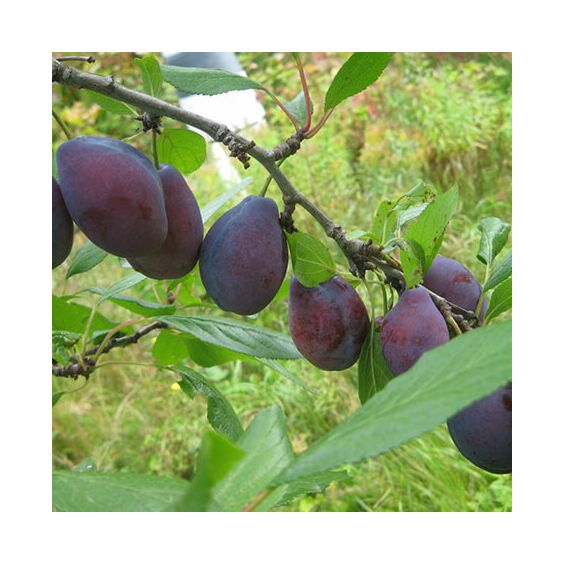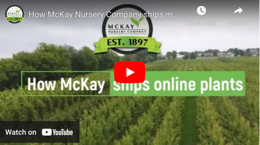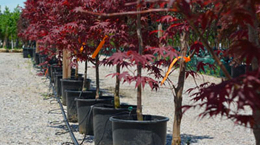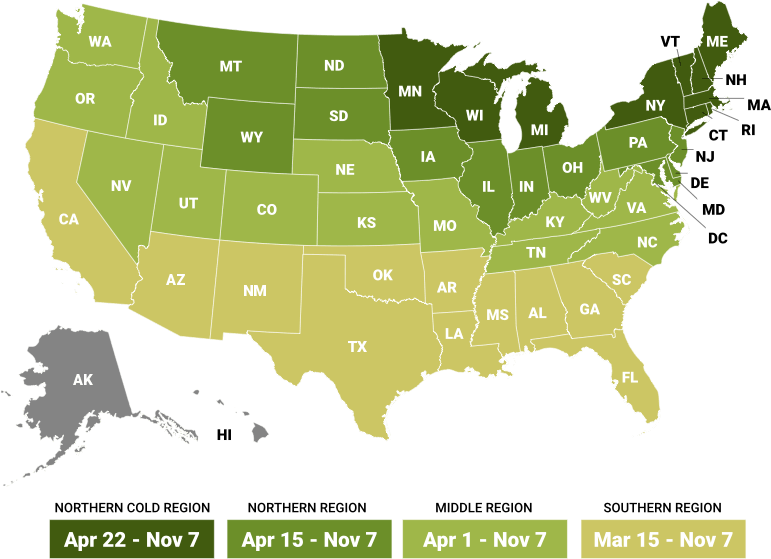
Growing zones
See Zone Map >Status: Out of stock
Mature Plant Size (H x W): 8-12' x 8-12'
- Walnut Toxicity Resistant
- Edible to People
Planting & Care for Edible Plants – Plums
Preparation
- Even though plum trees don’t need fertilizer when planted. Once they’re established, fruit production requires regular fertilizing all year long.
- Most plum trees need cross-pollination to produce fruit. Make sure you plant more than one variety when planting.
- There are three categories of plum trees: European, Japanese, and American Hybrids. European - work in most regions across the U.S. Japanese - flourish where peach trees flourish. Lastly, American hybrids that work well in regions where neither European nor Japanese types flourish.
- Plant plum trees in well-drained, moderately fertile soil in full sun. Avoid planting in low areas where frost may settle, this will damage your trees.
Opening Plant Material
- Bare Root - Cut open the bundle (top and roots are tied) and separate all the plants. Soak roots in buckets of water until planted. Each plant type will be labeled separately for identification. Do not expose the roots to sun. They should never dry out. Keep roots covered. All bare-root plants must be trimmed when planted.
- Containers - Completely saturate all container plants by putting in a larger container of water until stops bubbling, remove. Now ready to plant. Dig a hole no deeper than the depth of the container and 6" or more, making sure it’s wider on the sides.
Planting Bare Root
- Plant Bare root in fall. A good indicator if you can still plant is if the ground is still workable you’re good to go. If a hard frost is expected be sure to hold off on planting.
- Dig a hole at least 6" wider and the same depth as the root mass. The crown or graft of the plant should be slightly higher than ground level where it was grown at the nursery.
- Trim off the broken roots and branches.
- Spread the roots and fill halfway with soil, then water until soil settles completely saturating the soil and planting pit.
- Re-adjust plant and fill the hole with the rest of the soil.
- Back fill the balance of the soil and water well.
- See our link below “Handling & Planting Guidelines” for illustrations on planting.
Planting containers
- Slide plant from pot by tapping on the bottom of the pot.
- With shovel or knife trim bottom 2" off of the root ball for plants in plastic containers.
- Rotate the plant to the proper position. Never lift or move plants by the tops.
- Place the root ball in the hole.
- Notice where the base of the trunk flairs out from the tree. This is called the root flair. This root flair should show when the tree is planted. If necessary, add soil under the ball so the root flair is exposed.
- Backfill the hole with soil, making sure the top of the root ball is visible and slightly higher than the soil around it.
- Firm the soil around the plant. Water well to settle soil around the root ball.
Pruning – After Planting
- Bare Root - Prune ALL bare root plants to reduce transplant shock and ensure success. Pruning should occur either before or as soon after planting as possible. All pruning should be done with a sharp pruning shears.
- Containers - Although it is not essential for containers to be pruned after planting, a light pruning for shape, to remove any broken branches from shipping, or to thin out a heavily branched plant will help in the transplanting process and in the appearance of your new planting.
Pruning - Through-out the Season
- Thinning plum trees is important to prevent branches breaking under the weight of the trees. If branches do break, prune them back into the undamaged wood, ideally cutting back to a natural fork to avoid leaving stubs.
- Prune early spring or mid-summer to avoid infection. The best time for pruning is usually spring for young trees and mid-summer for established ones.
- Do NOT prune in the fall or winter injury or infection may occur.
- Each of the three different varieties require different pruning, be sure to do your research before pruning your variety.
Harvesting
- Plums have the best flavor when left to ripen on the tree. You can tell when plums are ripe by applying gentle pressure with your fingers. If the skin of the fruit feels soft, then it is ready to be picked.
- Plums should come off the tree easily when you’re using only a slight twist.
- Unfortunately, the fruit does not store for long, so they must be eaten or preserved right away.
Watering - After Planting
- Plants typically take approximately 6 weeks to establish new roots in your soil. During this period, water plants as often as every 2-4 days at the start and at least a minimum of once per week. Beyond the 6 week establishment period, water once per week, unless rains occur.
- Stick your finger into the soil around 3” to check soil moisture.
Watering - Through-out the Season
- After the first season, plants should only be watered during extended periods without rain.
- How do you know if your plants need water? The easiest way to tell is to touch the soil around the roots. If it is moist, there is no need to water. If it is dry, give it a good soaking with the hose end (no nozzle) watering the soil only, not the leaves.
- Stick your finger into the soil around 3” to check soil moisture.
Planting & Handling Help
Download our Planting and Handling Guide below to plan for a successful arrival and install of your plants. Be sure to water all plants as soon as they arrive and every day until you’re ready to plant. Keep any bare root bundles in a shady, cool spot with the roots covered at all times.


Learn More
Watch our videos on handling bare root plants, how your order is prepared for shipment and more.


Plant Sizing
What is the difference between Containers, Grow Bags, Bare Root, and Balled & Burlap (B&B)?
Shipping Times


Our FedEx and local shipping times depend on two factors, one is by the region and the second is the type of product being shipped. For example, small fruits are only shipped in spring, but majority of our perennials are shipped from spring until fall. Keep in mind the dates below act as a general guide. Due to unpredictable weather, staffing, inventory and industry demands these timelines can change. Therefore, we cannot guarantee any of these times.
Shipping Dates by Region*
Northern Cold Region: April 22nd - November 7th
Northern Region: April 15th - November 7th
Middle Region: April 1st - November 7th
Southern Region: March 15th - November 7th
Local Delivery (small radius from Waterloo, WI): April 22nd - November 7th
Shipping Dates by Season*
Spring Shipping: Region Start Date (above) - May
Fall Shipping: September - November
Due to unpredictable weather, these times may vary. Some varieties are exceptions due to heat and plant health reasons. Enter your shipping zip code at the top of this page and be sure to check the shipping information on each product before you add it to your cart. If the product is too large or restricted in your state, you will not be able to checkout with that item in your cart.
